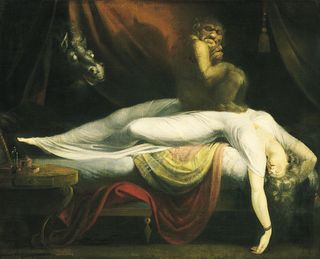The Demon on Your Chest and Other Terrifying Tales of Sleep Paralysis

An unusual condition called sleep paralysis has been frightening people for centuries, and now a new review sums up the many creepy stories from different cultures that try to explain the episodes of waking up and being unable to move.
Cultural explanations that try to account for the terrifying experience of waking up feeling paralyzed range from alien abductions to strange demons creeping into people's bedrooms and sitting on their chests, according to the review, published in September in the journal Frontiers in Psychology.
Together, the stories show how a single biological phenomenon can be interpreted differently by societies, the researchers, led by José F. R. de Sá of the Jungian Institute of Bahia in Brazil, wrote in their review.
The biological explanation of sleep paralysis is that two aspects of REM sleep — dreaming and paralysis — are occuring while a person is awake, said Brian Sharpless, an associate professor of clinical psychology at Argosy University in Washington, D.C., who was not involved with the review. Sleep paralysis occurs more often than most people think, and it is more likely to occur when a person is waking up than during other parts of sleep, he said. [Top 10 Spooky Sleep Disorders]
During REM, or rapid eye movement sleep, dreaming takes place and the brainstem paralyzes the body by inhibiting motor neurons, Sharpless told Live Science.
But normally, dreaming and paralysis occur when people are unconscious, said Sharpless, who is also the author of "Sleep Paralysis: Historical, Psychological and Medical Perspectives" (Oxford University Press, 2015).
When someone experiences sleep paralysis, these two things occur while a person is conscious, with his or her eyes open, Sharpless said. This means that the dreams are technically hallucinations, and they're just as vivid as anything you'd see when you're awake, he said. In addition, the dreams can be "multisensorial," meaning a person may not only see things, but hear and, in some cases, feel them too, he said.
Sign up for the Live Science daily newsletter now
Get the world’s most fascinating discoveries delivered straight to your inbox.
Sleep paralysis around the world
The sense of touch is very often highlighted in explanations of sleep paralysis around the world. Many cultures refer to a weight on the chest, according to the review.
In certain parts of Brazil, for example, there are folkloric tales of a creature with long fingernails that lurks on people's rooftops during the night. The creature, called "Pisadeira," comes into a person's house and tramples on the chests of those who sleep, according to the review. [7 Mind-Bending Facts About Dreams]
Catalonia, a region in Spain, has the tale of the "Pesanta," a black animal, often a dog or a cat, that invades people's homes and sits on their chests while they are asleep, making it difficult to breathe and causing nightmares, the authors wrote.
In Newfoundland, Canada, it's the "Old Hag" that comes and sits on a sleeping person. And among an ethnic group in Vietnam and Laos, a "pressing spirit" sits on sleepers' chests and tries to asphyxiate them, the researchers found.
The idea of a weight holding someone down is also reflected in the terminology used in Mexico to describe sleep paralysis, according to the review. Translated from Spanish, the phrase means "a dead body climbed on top of me."
Some cultures use tales of spells cast by shamans or summoners to explain sleep paralysis.
In Inuit culture, for example, people tell of shamans who can cast a spell when a person is sleeping, causing an experience called "uqumangirniq," during which a person can't move, talk or scream and is visited by a shapeless or faceless presence, according to the review.
And Japanese folklore refers to a summoner who calls upon a vengeful spirit to suffocate enemies through a phenomenon called the "kanashibari," which is "the state of being totally bound, as if constrained by metal chains," the review found.
In other cultures, ghosts or supernatural beings are the perpetrators.
In a study of Cambodian refugees from the 1970s, researchers found that many patients referred to something called "khmaoch sângkât" or "the ghost that pushes you down." In Thailand, a ghost called "phi am" haunts people when they are half asleep and unable to move. And in some traditional Chinese cultures, "ghost oppression" caused sleep paralysis, the researchers wrote.
The researchers noted that the purpose of the review was not to belittle the various spiritual explanations for sleep paralysis but rather to "enrich the knowledge about these experiences and their psychological and cultural aspects," they wrote.
Originally published on Live Science.

Most Popular




